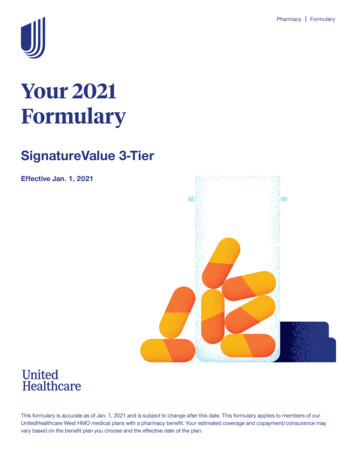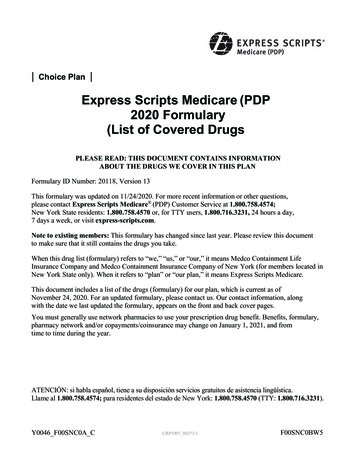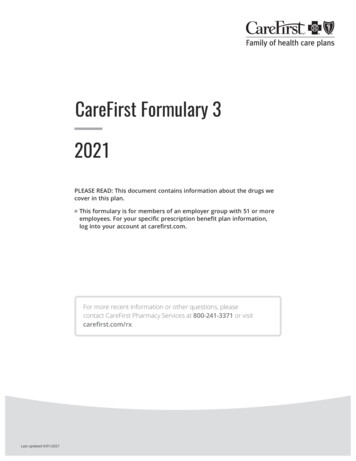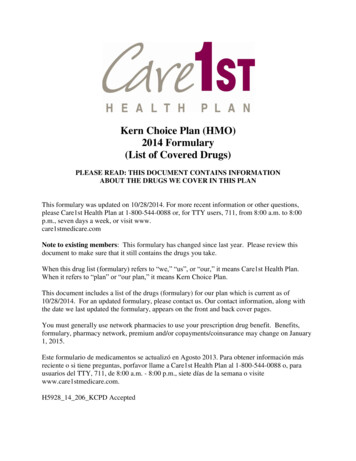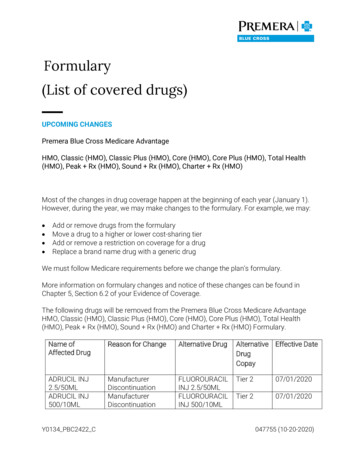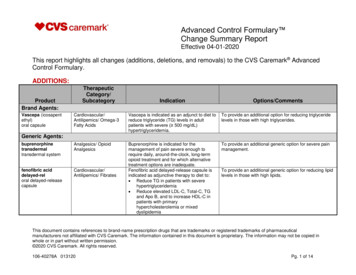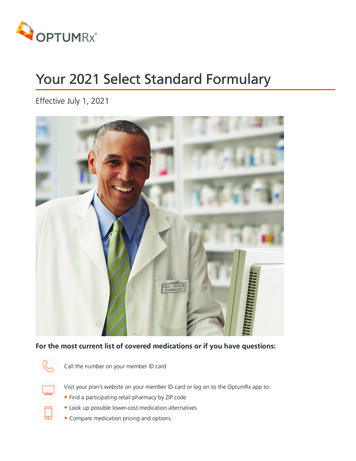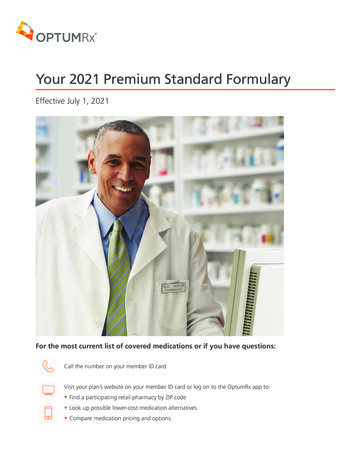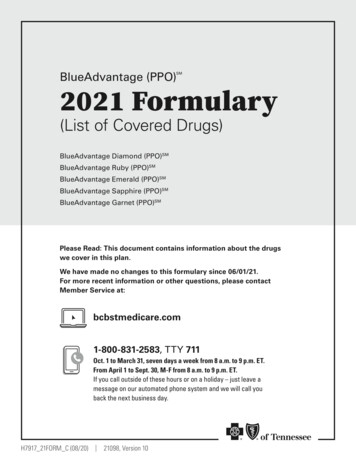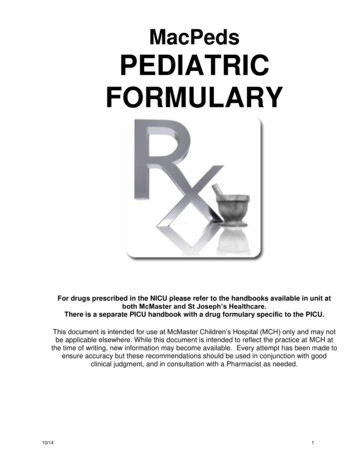
Transcription
MacPedsPEDIATRICFORMULARYFor drugs prescribed in the NICU please refer to the handbooks available in unit atboth McMaster and St Joseph’s Healthcare.There is a separate PICU handbook with a drug formulary specific to the PICU.This document is intended for use at McMaster Children’s Hospital (MCH) only and may notbe applicable elsewhere. While this document is intended to reflect the practice at MCH atthe time of writing, new information may become available. Every attempt has been made toensure accuracy but these recommendations should be used in conjunction with goodclinical judgment, and in consultation with a Pharmacist as needed.10/141
Unapproved Abbreviations, Symbols and Dose Designations and Acceptable gUnitInternationalunitAbbreviations forDrug NamesProblemMistaken for “0” (zero), “4” (four), or cc.Mistaken for “IV” (intravenous) or “10” (ten).Misinterpreted because of similar abbreviations for multipledrugs; e.g., MS, MSO4 (morphine sulphate), MgSO4(magnesium sulphate) may be confused for one another.QDQODEvery dayEvery other dayODOS, OD, OUEvery dayLeft eye, righteye, both eyesMistaken for “right eye” (OD oculus dexter)May be confused with one another.AS, AD, AULeft ear, rightear, both earsMay be confused with one another.D/CDischarge ordiscontinueSC, SQ, or sub qSubcutaneousccCubic centimetrePremature discontinuation of medications if D/C (intendedto mean “discharge”) has been misinterpreted as“discontinued” whenfollowed by a list of discharge medicationsSC mistaken as SL (sublingual); SQ mistaken as “5 every;”the “q” in “sub q” has been mistaken as “every” (e.g., aheparin dose ordered “sub q 2 hours before surgery”misunderstood as every 2 hours before surgery)Mistaken for “u” (units).μgMicrogramUnapprovedSymbol@ IntendedMeaningatGreater than UnapprovedDoseDesignationTrailing zeroLess thanQD and QOD have been mistaken for each other, or as‘qid’. The Q has also been misinterpreted as “2” (two).Mistaken for “mg” (milligram) resulting in one thousand-foldoverdose.Potential ProblemMistaken for “2” (two) or “5” (five). Use “at”.Mistaken for “7”(seven) or the letter “L” .Confused with each other.IntendedMeaningPotential ProblemX.0 mgOr 10.0 mgDecimal point is overlooked resulting in 10-fold dose error.AcceptableCorrectionUse 'unit'.Use 'unit'.Do not abbreviatedrug names.(exceptions: ASA,KCl, Humulin R)Write “daily” and“every other day”in fullWrite “daily”Use “left eye”, “righteye” or“both eyes”.Use “left ear”,“right ear” or “bothears”Use “discharge” and"discontinue".Use "subcut" or"subcutaneous"Use “mL” or“millilitre”.Use “mcg ormicrogram”.AcceptableCorrectionWrite out “at” in fullWrite out “greaterthan” in fullWrite out “less than”in fullAcceptableCorrectionNever use a zero byitself aftera decimal point.Use “X mg or 10mg”Lack of leading. X mgDecimal point is overlooked resulting in 10-fold dose error.Always use a zerozerobefore adecimal point. Use“0.X mg”Adapted from ISMP’s List of Error-Prone Abbreviations, Symbols, and Dose Designations (2010) and ISMP Canada’s Do NotUse – Dangerous Abbreviations, Symbols and Dose Designations (2006)10/142
Legend:GASGPGPCGNGNBMAXMINNF10/14Group A StreptococcusGram PositiveGram Positive CocciGram NegativeGram Negative BacilliMaximumMinimumNon-Formulary At HHSAdjust dosinginterval for patientswith renal impairment.3
Safer Order WritingTo reduce the potential for medication errors: Write orders clearly and concisely. Write medication orders using generic drug names only. Be careful with mg/kg/DAY vs mg/kg/DOSE. Include the intended dose per kilogram on each order. Write the patients weight on each order sheet. Never place a decimal and a zero after a whole number (4.0 mgshould be 4 mg) and always place a zero in front of a decimal point(.2mg should be 0.2 mg). The decimal point has been missed andtenfold overdoses have been given. Never abbreviate the word unit. The letter U has beenmisinterpreted as a 0, resulting in a 10 fold overdose. Always order medications as mg, not mL as differentconcentrations may exist of a given medication. There are a fewexceptions such as co-trimoxazole (Septra ). QD is not an appropriate abbreviation for once daily, it has beenmisinterpreted as QID. It is best to write out “once daily” or “q24h.” Do not abbreviate drug names (levo, 6MP, MSO4, MgSO4, HCTZ). Do not abbreviate microgram to g, use mcg, or even safer, writeout microgram or use milligrams if possible (0.25 mg instead of250 micrograms)10/144
ANTIBACTERIALSCELL WALL SYNTHESIS INHIBITORS (BACTERICIDAL) -LACTAMSPENICILLINSbenzyl penicillin: narrow spectrum; NOT Penicillinase resistantPenicillin G (IV or IM) Moderate to Severe Infections:IV: 100 000 - 400 000 Units/kg/DAY q4-6h (MAX: 24 million Units/DAY)Penicillin V Meningitis: IV: 400 000 Units/kg/DAY q4h (MAX: 24 million Units/DAY)Potassium (PO)Suspension: 60mg/mL Penicillin V Potassium (oral):Tablet: 300mg1. Mild to moderate Group A Strep infections: 25-50mg/kg/day PO q8-12h x 10 days Penicillin V 500 000 units isequivalent to 300 mg.IDSA (GAS pharyngitis)– Children: 300mg bid-tid; Adolescents & adults: 600mg po BID x 10days2. Rheumatic fever (treatment): 27kg: 300mg PO bid x 10 days; 27kg: 600mgPO BID x 10 days3. Rheumatic fever (prophylaxis AND 5 yrs): 300mg PO bid4. Prophylaxis in asplenics:6 months – 5 yrs: 150mg PO bid 5 yrs: 300mg PO bidisoxazoyl penicillin: narrow spectrum; Penicillinase resistantCloxacillin (IV or PO) Primarily used in methicillin-sensitive Staphylococcus aureus (MSSA) infections:IV: 100-200 mg/kg/DAY q4-6h (MAX: 12 g/DAY); up to 300mg/kg/DAY may be used inOral: select cases (please consult Infectious Diseases)Suspension 25mg/mLCapsule: 250mg, 500mg10/14PO: Suggest to use cephalexin (1st generation cephalosporin) in place as cloxacillin has loworal bioavailability, poorly tolerated (GI side effects) and need to be taken on an emptystomach5
Aminopenicillin: Penicillinase sensitiveAmpicillin (IV)Meningitis:IV: 300-400 mg/kg/DAY q4-6h (MAX: 12 g/day)Other infections: IV: 100-200 mg/kg/DAY q6h (MAX: 2 g/DOSE)Amoxicillin (PO)For coverage against Streptococcus pneumoniae (including empiric therapy for communityacquired pneumonia or otitis media): PO 80-90mg/kg/DAY q8h (MAX: 1 g/DOSE)Standard dose: PO: 40-50 mg/kg/DAY q8hSuspension: 50mg/mL(supplied at HHS);GAS pharyngitis: PO: 50mg/kg ONCE daily (MAX: 1000mg/DOSE)25mg/mLOR 25mg/kg (MAX: 500mg/DOSE) BIDClavulanic Acid: Enhances spectrum; beta-lactamase inhibitorAmoxicillin Clavulanic Acid For coverage against Streptococcus pneumoniae (i.e. sequential oral therapy in(Clavulin) (PO) complicated CAP, AOM, sinusitis): 80-90mg/kg/DAYof amoxicillin component q8hTablets (amoxicillin/clavulanic acid): **BID dosing may be adequate for AOM, but TID dosing is recommended for500/125mg(4:1); 875/125mg(7:1) pneumonia**Beginning in fall 2014:Suspension (supplied as HHS): 1 mL Standard dosing for other gram positive, gram negative, anaerobic infections: 80mg amoxicillin and 11.4mg PO: 30-50 mg/kg/DAY of amoxicillin component q8-12h (MAX: 500 mg/DOSE)clavulanic acid (7:1)*One major side effect with clavulanic acid (particularly at high doses) is GIintolerance**When writing discharge prescription and if suspension is required, please indicate(particularly if high dose amoxicillin is used) the formulation of the amoxicillinclavulanic acid is specified. Example of prescription:Amoxicillin clavulanic acid suspensionPlease dispense as 7:1 formulation (80mg/mL amoxicillin 11.4mg/mL clavulanicacid) 480mg (of amoxicillin component) po TID x 10 days10/146
ANTIBACTERIALS (CONTINUED)PENICILLINS (CONTINUED)Ureidopenicillin: broad spectrum; Penicillinase sensitive Tazobactam: Enhances spectrum; β-lactamase inhibitorPiperacillin (IV) For documented Pseudomonas aeruginosa infectionsIV: 200-300 mg/kg/DAY q6h (MAX: 16 g/DAY)Piperacillin Tazobactam (IV) Broad coverage against many pathogens. First line for febrile neutropaenia.IV: 200-300 mg/kg/day (of Piperacillin component) q6-8h(Adult dose is 4.5g IV q8h)**Order antibiotic as x mg (or g) of piperacillin component IV q6-8h**CEPHALOSPORINS – do NOT cover MRSA, Enterococcus species, Listeria, or extended spectrum betalactamase producing organisms (ESBL)1st GenerationExcellent coverage against S. aureus, group A Streptococcus, E. coli, Klebsiella.Empiric therapy for cellulitis, osteomyelitis, bacterial adenitis.Cefazolin (Ancef) IV: 75-150 mg/kg/DAY q8h (MAX: 6 g/DAY)(IV or IM) Higher doses are needed for infections such as osteomyelitisCephalexin (Keflex) PO: 25-100 mg/kg/DAY qid(PO)Tablet: 250mg, 500mg Osteomyelitis following IV therapy: 100-150mg/kg/DAY (MAX: 4 g/DAY)Suspension: 50mg/mLnd2Generation10/14NO LONGER INDICATED FOR EMPIRIC TREATMENT OF PNEUMONIA. Theseagents offer no benefit compared to ampicillin/amoxicillin for treatment of S.pneumoniae. Main benefit is coverage against (nontypeable) H. influenzae andMoraxella, which cause sinusitis and otitis.Cefuroxime IV: 100-150 mg/kg/DAY q8h (MAX: 2g/DOSE)(IV or IM)7
Cefuroxime Axetil Poor oral bioavailability; unlikely to achieve optimal concentrations in severe(Ceftin) (PO) infectionsCefprozil (eg. for otitis media unresponsive to high-dose amoxicillin or for acute sinusitis)(Cefzil) (PO)Tablet: 250mg, 500mg PO: 15-30 mg/kg/DAY q12h (MAX: 1 g/DAY).Suspension: 50mg/mL3rd GenerationBroad spectrum activity against gram negatives. Ceftriaxone/cefotaxime offerexcellent coverage against Streptococcus pneumoniae and good coverage ofmethicillin sensitive S. aureus. Only ceftazidime is active against Pseudomonasaeruginosa. Useful for CNS infections.Cefotaxime **reserved for neonates**(IV or IM) Meningitis: IV: 200-225mg/kg/DAY q6h; up to 300mg/kg/DAY q6h may beused in infants and older children for this indication (MAX: 12 g/DAY) Otherinfections:IV: 100-200 mg/kg/DAY q6-8h (MAX: 6 g/DAY)Neonates greater than 2kg (if less than 2kg, please refer to neonatal dosinghandbook):0 – 7 days: 100-150mg/kg/DAY IV q8-12h 7 days: 150-200mg/kg/DAY IV q6-8h10/148
ANTIBACTERIALS (CONTINUED)CEPHALOSPORINSCeftriaxone Meningitis: IV/IM: 100mg/kg/DAY divided q12h or q24h (Max: 2g/DOSE)(IV or IM) Other infections: IV/IM: 50-75 mg/kg q24h (MAX: 2 g/DAY)STI (gonococcal infection): 45kg: 250mg IM x 1Ceftazidime Active against Pseudomonas aeruginosa:(IV or IM) IV: 75-150 mg/kg/DAY q8h (MAX: 6 g/DAY)Cefixime Increasing MIC (minimum inhibitory concentration) against Neisseria gonorrhea;(Suprax) (PO) avoid use if possible due to increased risk of treatment failure. IM ceftriaxone ispreferable.Tablet: 400mgSuspension: 20mg/mL Other infections (Not active against Pseudomonas and poor GP activity):PO: 8 mg/kg/DAY q12-24h (MAX: 400 mg/DAY)10/149
CARBAPENEMS – Very broad spectrum antibiotics (coverage against GP, GN and anaerobes includingextended beta-lactamase producing strains of GN); no coverage against MRSA ** Requires ID endorsement **Meropenem Meningitis: 40mg/kg/DOSE IV q8h (MAX: 2g/DOSE)(IV)Other infections: 20mg/kg/DOSE IV q8h (usual MAX: 1g/DOSE)Ertapenem 3 months - 12 years : 15mg/kg/DOSE IV q12h (max: 1 gram/DAY)(IV) 13 years: 1 g IV once daily (max: 1 gram/DAY)GLYCOPEPTIDESVancomycin(IV or PO)The IV formulation willbe provided whenprescribed orally whilein hospitalOnly active against GP (including MRSA). Use as an alternative for GP coverage in patientswith severe penicillin allergy (i.e. anaphylaxis, angioedema)Meningitis: IV: 60 mg/kg/DAY q6h (MAX: 4 g/DAY)Other infections (MRSA or Coagulase Negative Staphylococci):IV: 40-60 mg/kg/DAY q6-12h (usual MAX: 2 g/DAY)Higher doses may be required in patients with suspected/confirmed MRSA infections, orindividuals who are in clinically severe sepsisInfuse over a minimum of 1 hour to avoid Red Man Syndrome; If reaction occurs, increaseinfusion time. In patients with known history of Red Man Syndrome, write on order to infuseover at least 2 hours.Monitor trough levels in patients with septic shock, proven MRSA infections,concurrent nephrotoxins, fluctuating renal function or extended treatment coursesClostridium difficile infection (usually reserved for severe infection or failed metronidazole):PO: 12.5 mg/kg/DOSE q6h (MAX: 125 mg/DOSE)10/1410
ANTIBACTERIALS (CONTINUED)Protein Synthesis InhibitorsVIA 50S Ribosome (Bacteriostatic)MACROLIDESAtypicals: Mycoplasma, Legionella, Chlamydia, H. pyloriGAS and S. pneumoniae infections in patients with severe penicillin allergy (although substantialmacrolide resistance has been observed with these pathogens).Clarithromycin Useful for mild bacterial pneumonia in adolescents. Also commonly used for atypicalmycobacterial infections.Tablet: 250mg, 500mg PO:7.5 mg/kg/DOSE BID (Max: 500mg/DOSE)Suspension:25mg/mL, (50mg/mLnot available at HHS) Rx Interactions: theophylline, carbamazepine, cisapride, digoxin, cyclosporine, tacrolimus.Azithromycin Useful for known atypical respiratory infections and bacterial enteritis. AVOID USING TOTREAT INFECTIONS PRESUMED TO BE CAUSED BY GROUP A STREPTOCOCCUS ORTablet: 250mg PNEUMOCOCCUS.Suspension:PO/IV:10 mg/kg (MAX: 500 mg) once, then 5 mg/kg (MAX: 250 mg) q24h for 4 days40mg/mLLINCOSAMIDESClindamycinCapsule: 150mg,300mgSuspension15mg/mL10/14Pertussis: 10 mg/kg PO/IV q24h for 5 daysChlamydia trachomatis urethritis or cervicitis:PO: ( 1 month) 12 – 15mg/kg once (MAX: 1g)Useful for toxic shock syndromes, anaerobic infections of the head and neck, and forsusceptible S. aureus (including some MRSA) and group A streptococcus infections. Be careful– resistance in S. aureus is not particularly uncommon!IV: 30-40 mg/kg/DAY q8h (usual MAX: 600 mg/DOSE; 900mg IV q8h is usually prescribedin the setting as adjunct therapy in gram positive toxic shock or necrotizing fascitis)PO: 10-30 mg/kg/DAY q6-8h (MAX: 450 mg/DOSE)May potentiate muscle weakness with neuromuscular blockers. Oral suspension is very poorlytolerated, avoid if possible, use 150 mg capsules
Write medication orders using generic drug names only. Be careful with mg/kg/DAY vs mg/kg/DOSE. Include the intended dose per kilogram on each order. Write the patients weight on each order sheet. Never place a decimal and a zero after a whole number (4.0 mg should be 4 mg) and always place a zero in front of a decimal point (.2mg should be 0.2 mg). The decimal point has been missed and .
